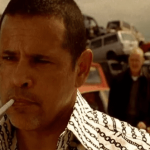 Weird Stuff
Weird Stuff  Weird Stuff
Weird Stuff  History
History 10 Legends Whose Last Moments Undid Their Glory
 Health
Health 10 Futuristic Ideas to Treat Common Medical Problems
 Weird Stuff
Weird Stuff Ten Surreal Attempts to Reverse Baldness
 Facts
Facts 10 U.S. Government Contingency Plans for the Unthinkable
 History
History 10 Weird Distractions from the Great Depression
 Movies and TV
Movies and TV 10 Fictional Kings Who Go from Good to Bad
 Food
Food The Fantastic Chemistry Behind Why 10 Popular Foods Taste So Good
 Technology
Technology 10 Futuristic Fungal Technologies
 History
History 10 Not-so-Spooky Events That Also Happened on October 31
 Weird Stuff
Weird Stuff 10 Things So Rare They’ve Only Been Found Once
 History
History 10 Legends Whose Last Moments Undid Their Glory
 Health
Health 10 Futuristic Ideas to Treat Common Medical Problems
Who's Behind Listverse?

Jamie Frater
Head Editor
Jamie founded Listverse due to an insatiable desire to share fascinating, obscure, and bizarre facts. He has been a guest speaker on numerous national radio and television stations and is a five time published author.
More About Us Weird Stuff
Weird Stuff Ten Surreal Attempts to Reverse Baldness
 Facts
Facts 10 U.S. Government Contingency Plans for the Unthinkable
 History
History 10 Weird Distractions from the Great Depression
 Movies and TV
Movies and TV 10 Fictional Kings Who Go from Good to Bad
 Food
Food The Fantastic Chemistry Behind Why 10 Popular Foods Taste So Good
 Technology
Technology 10 Futuristic Fungal Technologies
 History
History 10 Not-so-Spooky Events That Also Happened on October 31
10 Marketing Risks That Actually Paid Off
Playing it safe rarely gets attention. In today’s crowded marketplace, boldness often beats polish, and brands willing to take a gamble are the ones that break through. These companies took huge, sometimes reckless chances with their branding—whether by embracing controversy, mocking themselves, or turning conventional wisdom on its head. Some leaned into uncomfortable truths. Others bet everything on bizarre stunts, political firestorms, or total rebrands.
Any one of these ideas could’ve backfired spectacularly, tanking their reputations or alienating core customers. Instead, they became case studies in marketing bravery—risks that didn’t just pay off but redefined what their brands stood for. In hindsight, they seem genius. At the time, they looked insane.
Related: 10 Totally Deceptive Marketing Tactics Exposed
10 Nike Took a Knee with Colin Kaepernick
In 2018, Nike launched one of the most controversial campaigns in its history by centering an ad around Colin Kaepernick, the NFL quarterback who had become a national flashpoint for kneeling during the national anthem to protest racial injustice. The ad, which featured Kaepernick’s face with the words, “Believe in something. Even if it means sacrificing everything,” aired during the NFL season, knowing full well it could enrage football fans, conservative viewers, and potentially even their own athletes under contract. The backlash was instant—people posted videos burning their Nike shoes, and hashtags like #BoycottNike trended for days.
But Nike wasn’t shooting in the dark. Internal data showed its core demographic—young, urban, socially conscious consumers—viewed Kaepernick as a hero, not a liability. Sales surged 31% in the first weekend alone, and social media engagement broke records. Nike’s stock hit an all-time high within two months, and Kaepernick became a long-term face of the brand alongside LeBron James and Serena Williams. The campaign won an Emmy and a Cannes Lion and rewrote the playbook on how brands can take a stand without self-destructing.[1]
9 Old Spice Got Weird—and It Worked
Old Spice was once a go-to brand for dads and grandpas, but by the late 2000s, it had become a dusty relic on drugstore shelves, losing ground to edgier rivals like Axe. Then came 2010’s “The Man Your Man Could Smell Like,” featuring Isaiah Mustafa in a hyper-stylized, surreal commercial that included spontaneous shirt removal, teleporting showers, diamonds spilling from hands, and a final scene with Mustafa on a horse. It was unlike anything in men’s grooming. The risk? It could’ve seemed like a desperate joke, especially for a brand that hadn’t been cool in decades.
Instead, it became a viral phenomenon. Within 72 hours, the YouTube video had millions of views. But what sealed the campaign’s place in marketing history was what came next: The brand launched a massive real-time engagement stunt, producing over 180 personalized video replies from Mustafa to fans on Twitter and Reddit—including messages to Ellen DeGeneres, Digg users, and even a marriage proposal. The internet exploded. Old Spice body wash sales doubled, and the brand leapfrogged to become America’s #1 men’s grooming product.[2]
8 Burger King Told Customers to Eat at McDonald’s
During the economic chaos of the COVID-19 pandemic in 2020, Burger King UK posted a jaw-dropping message on Twitter: “Order from McDonald’s.” The tweet went on to encourage people to order from any fast food chain—”KFC, Subway, Domino’s, Five Guys… or any of the thousands of small independent restaurants”—because they all needed support. It wasn’t a stunt to get attention. It was an emotional appeal for solidarity in the hospitality industry when tens of thousands of workers were being furloughed or laid off.
It was a bold move for a brand long known for trolling its rivals, especially McDonald’s. Instead of trash talk or flame-grilled boasts, Burger King let empathy lead. The tweet went viral, praised for maturity, selflessness, and leadership during a crisis. News outlets worldwide picked it up, and positive sentiment for Burger King spiked across all age groups. The company reinforced its position as a brand with both flavor and heart. It also helped rally public attention to an entire sector on the verge of collapse.[3]
7 Volvo Let a Truck Drive Over Jean-Claude Van Damme
In 2013, Volvo Trucks wanted to promote its new precision steering technology. Instead of doing technical demos, they hired Jean-Claude Van Damme to perform an epic split between two moving Volvo semi-trucks, timed perfectly as they drifted backward down an empty runway at sunrise. It was breathtaking, bizarre, and dangerous—one slip and the video would become a PR disaster or worse. The trucks and stunt were real, and Van Damme had no safety harness visible.
The gamble paid off immediately. The video went viral with over 100 million views in a matter of days, sparking thousands of parody videos and social media challenges. Sales of Volvo Trucks in key markets rose over 30%, and the brand gained prestige outside its typical industrial audience. The campaign swept every major ad award and elevated the entire Volvo brand as one that makes rugged machinery elegant and precise. Van Damme’s performance also gave him a pop culture resurgence.[4]
6 Liquid Death Sold Water Like It Was Beer
Launching in 2019, Liquid Death marketed itself as canned mountain water—but with branding that looked like a heavy metal record label. Its tallboys featured gothic skulls and slogans like “Murder Your Thirst.” They ran ads showing waterboarding (with water), fake infomercials with possessed children, and videos of their cans being exorcised. All for plain still or sparkling water, sourced from the Alps. Critics said the edgy marketing was all style and no substance, and major retailers hesitated to carry it.
But the brand carved out a new identity: water for people who hate health branding [LINK 5]. Punk bands, MMA fighters, tattoo artists, and skaters began endorsing it. The company even offered a “sell your soul” contract as a legal joke on their site. By 2023, Liquid Death was valued at over $700 million, stocked in Whole Foods, 7-Eleven, and Target, with celebrity investors like Tony Hawk and Wiz Khalifa. All while selling water in tall cans with no alcohol, caffeine, or sugar—just attitude.[5]
5 Apple’s 1984 Ad Nearly Didn’t Air
Apple’s legendary “1984” Super Bowl commercial, directed by Ridley Scott, cost nearly $1 million to produce—a massive spend at the time. The minute-long ad depicted a dystopian, Orwellian world being shattered by a hammer-throwing rebel, symbolizing the upcoming release of the Macintosh computer. But when Apple’s board saw the finished ad, they were horrified. They thought it was too weird, confusing, and abstract for a tech product. They wanted to pull the plug entirely and sell back the Super Bowl airtime.
Steve Jobs and marketing lead Lee Clow pushed forward anyway. The ad aired only once, during the third quarter of Super Bowl XVIII in 1984. That single airing was enough: news outlets replayed it endlessly, calling it revolutionary. Apple’s Macintosh launch just two days later was a massive success. The ad is now considered one of the greatest commercials ever and has been preserved in the Museum of Modern Art. Had the board prevailed, the world might never have associated Apple with rebellion and creativity.[6]
4 Patagonia Told You Not to Buy Their Jacket
On Black Friday 2011, Patagonia ran a full-page ad in the New York Times with the headline: “Don’t Buy This Jacket.” Below it was a photo of their best-selling fleece. The copy urged consumers to think twice before purchasing more stuff, detailing the environmental cost of producing even one eco-friendly product. The company wasn’t promoting a sale or a new product—it was calling out the entire culture of overconsumption, including its own role in it.
The ad could’ve killed holiday sales or made Patagonia look self-righteous. Instead, it amplified its credibility with eco-conscious consumers, driving brand trust sky-high. Sales rose over 30% the next year, and the company doubled down with Worn Wear (a resale marketplace), lifetime guarantees, and a commitment to donate all profits to environmental causes. In 2022, its founder transferred ownership of the entire company to a climate trust, aligning the brand’s messaging with radical corporate action. They proved authenticity isn’t just marketing.[7]
3 Carlsberg Admitted Its Beer Wasn’t the Best
Carlsberg’s iconic tagline—”Probably the best beer in the world”—was widely known in Europe. Still, by the late 2010s, the brand’s quality had slipped drastically after years of cost-cutting. Sales in the UK were falling, and younger drinkers saw Carlsberg as outdated. So the company did the unthinkable: they launched a campaign that began with “Probably not the best beer in the world” and admitted their product had gotten bad.
They highlighted angry tweets, low ratings, and brutal taste test results, then announced a new brewing process with better ingredients and a smoother finish. They even released videos of Carlsberg staff reading customer insults out loud. The campaign drew massive attention for its honesty and transparency. Within months, Carlsberg saw a lift in both sales and brand sentiment, especially among younger drinkers who appreciated the reset. A follow-up campaign kept the cheeky tone: “New Carlsberg Pilsner: Rebrewed From Head to Hop.”[8]
2 Reddit Spent Its Entire Super Bowl Budget on a 5-Second Ad
Super Bowl ads are the holy grail of brand exposure—but most companies play it safe, going for crowd-pleasing humor or celebrity cameos. Not Reddit. In 2021, the company spent its entire ad budget on a 5-second glitch-style commercial that looked like a broadcast error. The screen blinked to a block of text referencing the recent GameStop stock saga, Reddit’s community power, and the idea that “underdogs can accomplish just about anything.” Most viewers missed it live.
But the internet did not. People rewound, paused, and screenshotted the ad, posting it across social media. The earned media was massive: Reddit trended on Twitter, news outlets dissected the message, and engagement on the platform spiked. It was a $1 million, blink-and-you-miss-it gamble that turned into tens of millions of dollars in free exposure, all while reinforcing Reddit’s brand identity as a chaotic, community-powered disruptor.[9]
1 Domino’s Admitted Their Pizza Was Terrible—And Customers Loved It
In 2009, Domino’s was in serious trouble. Years of poor reviews, taste test losses, and internet ridicule had cemented their reputation as a fast-food chain with pizza that “tastes like cardboard.” But instead of quietly tweaking their recipe, Domino’s made the boldest move possible: they publicly admitted their pizza sucked. The “Pizza Turnaround” campaign featured real employees reading brutal customer feedback aloud on camera—things like “worst pizza I ever had” and “the crust tastes like microwaved Styrofoam.” The company then documented its entire recipe overhaul process, including chefs rebuilding the sauce, dough, and cheese blend from the ground up.
It was an enormous risk. Most brands avoid even a whiff of public self-criticism, let alone making it their entire marketing strategy. Domino’s could have lost loyal customers who actually liked the old product or simply have drawn more attention to its faults. But the gamble paid off: the new pizza earned better reviews, the campaign was praised for its honesty, and Domino’s stock price tripled over the next few years. The company leaned into its “work-in-progress” image and won back lapsed customers by showing it was listening. The campaign is now used in MBA and advertising courses as a masterclass in turning self-awareness into success.[10]








